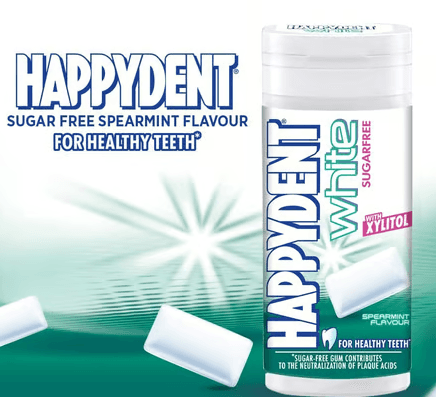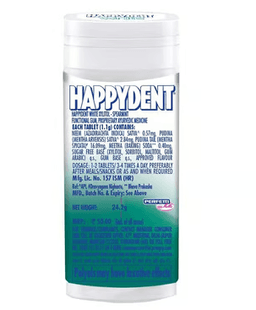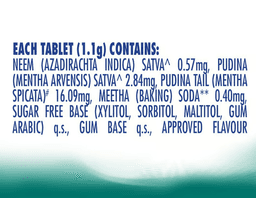Product Analysis Report
Comprehensive Safety Assessment




Potential Harmful Content:
Sorbitol
Maltitol
Approved Flavour
Overview
This is an analysis of Happydent White Spearmint gum. The ingredients list includes several components with potential health implications. Neem (Azadirachta indica) Satva and Pudina (Mentha arvensis) Satva are traditional Ayurvedic ingredients. Neem is known for its antibacterial and antiseptic properties, potentially benefiting oral health. Pudina (mint) provides a refreshing flavor and may have mild antiseptic qualities. Meetha (Baking) Soda is used as a mild abrasive and pH adjuster, which can help neutralize plaque acids. Sugar-free base includes Xylitol, Sorbitol, and Maltitol. Xylitol is beneficial for dental health as it inhibits the growth of Streptococcus mutans, a bacteria responsible for tooth decay. Sorbitol and Maltitol are sugar alcohols that provide sweetness with fewer calories than sugar, but they can cause gastrointestinal issues like bloating and diarrhea in some individuals, especially when consumed in large amounts. Gum Arabic is a natural gum used as a stabilizer and thickener. Gum Base is the non-nutritive, masticatory substance of chewing gum. Approved Flavour: The term 'Approved Flavour' is vague and doesn't specify the exact flavoring agents used. This lack of transparency is a concern because some artificial flavors can cause allergic reactions or sensitivities in certain individuals. Consumers may prefer more specific information about the flavoring components. The product claims that sugar-free gum contributes to the neutralization of plaque acids, which is a scientifically supported benefit, particularly when the gum contains xylitol.
Trustworthiness
Further research may be needed regarding the 'Approved Flavour' component. While the product contains beneficial ingredients like Xylitol and Neem, the potential gastrointestinal effects of Sorbitol and Maltitol should be considered, especially for those sensitive to sugar alcohols. The lack of specific information on the flavorings also raises a minor concern.
Misleading Information
The term "Approved Flavour" lacks transparency and could be misleading as it doesn't specify the exact flavoring agents used, which may hide potential allergens or undesirable additives.
Final Recommendation
The gum is generally safe for consumption, offering potential dental benefits from xylitol and neem. However, individuals sensitive to sugar alcohols should be cautious due to the presence of sorbitol and maltitol. The lack of transparency regarding the 'Approved Flavour' is a minor concern, prompting a need for further investigation by the consumer if they have specific allergies or sensitivities.
Sources or Further Readings
1. Neem: Alzohairy, M. A. (2016). Therapeutics Role of Azadirachta indica (Neem) and Its Active Constituents in Diseases Prevention and Treatment. Evidence-Based Complementary and Alternative Medicine, 2016, 7384251. 2. Xylitol: Ur-Rehman, S., Fatima, Z., Bajwa, S., Razzaq, N., Sadique, A., & Mehmood, T. (2015). Xylitol: a review on its production, properties, applications and commercial availability. LWT - Food Science and Technology, 63(2), 895-901. 3. Sorbitol and Maltitol: EFSA Panel on Food Additives and Nutrient Sources added to Food (ANS). (2011). Scientific Opinion on the safety of sorbitol for use as a food additive. EFSA Journal, 9(11), 2440. EFSA Panel on Food Additives and Nutrient Sources added to Food (ANS). (2011). Scientific Opinion on the safety of maltitol for use as a food additive. EFSA Journal, 9(11), 2439.